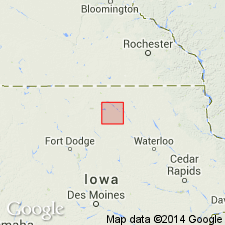
- Usage in publication:
-
- Mason City substage
- Modifications:
-
- Described
- Dominant lithology:
-
- Limestone
- Dolomite
- Sandstone
- AAPG geologic province:
-
- Iowa shelf
Summary:
Pg. 145-160. Mason City substage of Cerro Gordo County, is equal to upper part of Cedar Valley limestone as developed in Johnson and adjacent counties. It consists of (descending): 22 feet of variable beds, 21 feet of argillite and argillo-dolomitic beds; 30 feet of stromatoporoid beds; 14 feet of regularly bedded white or light-gray fossiliferous limestone; 20 feet of dolomite, generally compact and regularly bedded; and 20 feet of earthy dolomite, including near top thin calcareous bed with peculiar stromatoporoids and PACHYPHYLLUM WOODMANI. Underlies Hackberry substage of Lime Creek shale or stage.
Source: US geologic names lexicon (USGS Bull. 896, p. 1316).
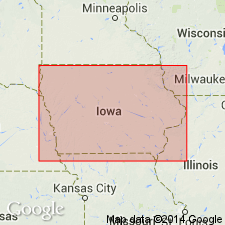
- Usage in publication:
-
- Mason City substage
- Modifications:
-
- First used
- AAPG geologic province:
-
- Iowa shelf
Summary:
Pg. 148. Mason City substage. [Only definition is use of name in table for upper part of Cedar Valley limestone, overlying Solon substage of Cedar Valley and underlying Lime Creek stage, in which was included the limestone later named Nora limestone by Thomas.]
Source: US geologic names lexicon (USGS Bull. 896, p. 1316).
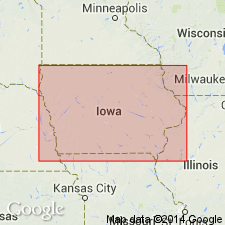
- Usage in publication:
-
- Mason City substage
- Modifications:
-
- Revised
- AAPG geologic province:
-
- Iowa shelf
Summary:
Restricted Mason City substage to lower heavily dolomitized part of beds previously included in Mason City, part of the upper beds being named by him Rock Creek substage and the uppermost beds (First ACTINOSTROMA zone) being included in his Nora substage. He defined type exposure of the Mason City as located at Nora Springs, "because the zones there are more distinct and their faunas more readily determined than at Mason City." He divided his Mason City into (descending) LEPIDOCENTRUS zone, TRIGONOTRETA zone, and AULOPORA zone.
Source: US geologic names lexicon (USGS Bull. 896, p. 1316).
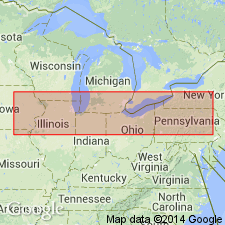
- Usage in publication:
-
- Mason City dolomite member
- Modifications:
-
- Revised?
- AAPG geologic province:
-
- Iowa shelf
McNair, A.H., 1942, Upper Devonian Bryozoa: Journal of Paleontology, v. 16, no. 3, p. 343-350.
Summary:
Pg. 349-350. Referred to as Mason City dolomite member of Shellrock [Shell Rock].
Source: US geologic names lexicon (USGS Bull. 1200, p. 2415).
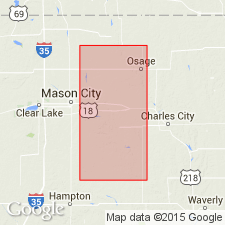
- Usage in publication:
-
- Mason City dolomite member
- Modifications:
-
- Overview
- AAPG geologic province:
-
- Iowa shelf
Summary:
Pg. 182 (table), 187. Shellrock [Shell Rock] consists of lithographic and dolomitic limestones and thin shales; includes (ascending) Mason City, Rock Grove, and Nora members.
Source: US geologic names lexicon (USGS Bull. 1200, p. 2415).
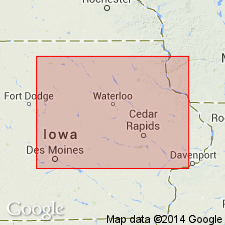
- Usage in publication:
-
- Mason City Member
- Modifications:
-
- Contact revised
- Overview
- AAPG geologic province:
-
- Iowa shelf
Summary:
Lower contact revised in that Mason City Member, basal member of Shell Rock Formation, upper formation of Cedar Valley Group (revised), overlies Idlewild Member (named), upper member of Lithograph City Formation (named) of Cedar Valley Group. Underlies Rock Grove Member of Shell Rock. Is dominated by skeletal limestone and dolomitic limestone (calcilutite and calcarenite), partly argillaceous. Includes prominent stromatoporoid biostromes at all localities. Has hardgrounds, discontinuity surfaces locally encrusted with edrioasteroids and auloporids. Becomes more dolomitic to west where it includes interbeds of "birdseye"-bearing intraclastic and laminated carbonates. Ranges from 6-11 m thick over most of its extent, but thins to 1.5 m in southernmost part. Nomenclature charts, graphic sections. Of Late Devonian, Frasnian age. Present in northern IA on the Iowa shelf.
Source: GNU records (USGS DDS-6; Denver GNULEX).
For more information, please contact Nancy Stamm, Geologic Names Committee Secretary.
Asterisk (*) indicates published by U.S. Geological Survey authors.
"No current usage" (†) implies that a name has been abandoned or has fallen into disuse. Former usage and, if known, replacement name given in parentheses ( ).
Slash (/) indicates name conflicts with nomenclatural guidelines (CSN, 1933; ACSN, 1961, 1970; NACSN, 1983, 2005, 2021). May be explained within brackets ([ ]).

